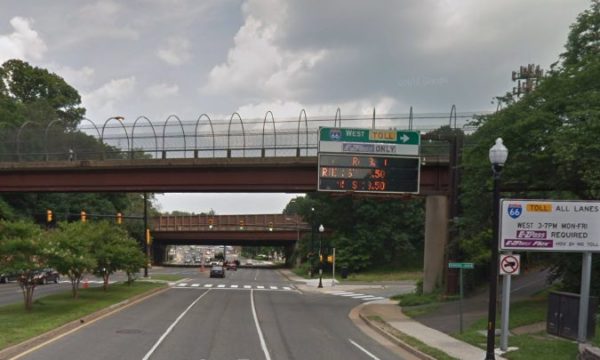Arlington is gearing up to ask for millions in I-66 toll revenue to fund a series of changes along Lee Highway, including the creation of a dedicated bus and HOV lane along the road during rush hours.
The County Board is set to sign off this weekend on funding requests for six transportation projects, totaling $6.9 million, four of which focus on reducing traffic along Lee Highway as it runs from Rosslyn to East Falls Church.
The Northern Virginia Transportation Commission doles out a portion of the revenues collected through the year-old I-66 toll program to localities, in order to help afford road improvements along the corridor inside the Beltway. Accordingly, Arlington is looking for cash for the following efforts along Lee Highway, per a county staff report:
Metrobus Route 3Y Service Improvements — $520,000 per year for five years, total request $2.6 million
This project will increase morning peak hour frequency and provide running time improvements for better on-time performance on the subject Metrobus route that connects the East Falls Church Metrorail Station with the Farragut Square and McPherson Square areas in the District of Columbia via Lee Highway and a short section of I-66 from Rosslyn to the Theodore Roosevelt Bridge.
Intersection Improvements at Lee Highway and Washington Boulevard — $400,000
This project will add a second left turn lane from northbound Lee Highway to westbound Washington Boulevard and provide pedestrian improvements at the intersection north of the bridge over I-66, which is 0.25 miles from the East Falls Church Metrorail Station.
Enhanced Vehicle Presence Detection on Lee Highway — $20,000 per intersection for 15 intersections, total request $300,000
This project will install forward looking infrared (FLIR) video cameras at key intersections along Lee Highway. FLIR technology uses thermographic cameras that improve the accuracy of vehicle, pedestrian, and bicycle detection in all lighting and weather conditions, and in turn improve optimal signal, intersection, and corridor operations and performance.
Design and Construct Peak Period, Peak Direction HOV and Bus-Only Lane on Lee Highway from just east of N. Kenmore Street to N. Lynn Street — $1.5 million
This project would convert the outside lane of Lee Highway to an HOV and bus only lane through pavement treatment, restriping, and signage. The lane would operate eastbound during the morning peak period and westbound during the evening peak period only; at other times it will continue as a general purpose travel lane.
The final project on the list is one that the county initially considered back in 2016 as an effort to prepare for Metro’s “SafeTrack” schedule disruptions, and the new lane would’ve run from Court House to Rosslyn. However, county transportation spokesman Eric Balliet says that lane was never constructed, and the new proposal calls for it to run from Cherrydale to Rosslyn instead.
The county expects a new lane would be particularly impactful along that section of the highway because about “25 loaded buses per hour” drive along it during peak period, and they often run into heavy delays near the highway’s intersection with N. Lynn Street in Rosslyn, according to the report.
In addition to the Lee Highway changes, officials are also hoping to earn $750,000 to add a new traffic light to the Washington Blvd entrance to the East Falls Church Metro station, as well as crosswalks and other pedestrian improvements at the intersection.
Finally, the county plans to ask for a total of $1.3 million over the next three years for “enhanced transportation demand management outreach” along the corridor, educating commuters about public transit and other strategies for getting cars off the road.
The Board is set to approve these funding requests at its meeting on Saturday (Dec. 15), and the NVTC will accept applications through Jan. 16. The organization plans to hand out $20 million in funding across the region through the program next year.
Photo via Google Maps


